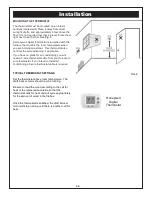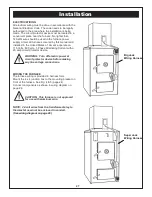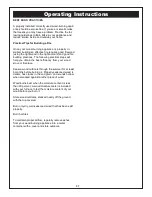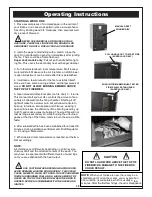
IMPORTANCE OF DRAFT
Draft is the force which moves air from the appliance
up through the chimney. The amount of draft in in your
chimney depends on the length of the chimney, local
geography, nearby obstructions and other factors.
Too much draft may cause excessive temperatures in
the appliance and damage the steel of the furnace.
Inadequate draft may cause back puffing into the room
and plugging of the secondary heat exchangers or
chimney.
CONDITIONS INDICATING INADEQUATE DRAFT
In adequate draft will cause the appliance to leak
smoke into the room through appliance and chimney
connector joints.
CONDITIONS INDICATING EXCESSIVE DRAFT
An uncontrollable burn or excessive temperature
indicates excessive draft.
PROPER CHIMNEY STACK HEIGHT
The chimney for this furnace should be a minimum of
15 feet high and sized properly. Poor draft may be
caused due to surrounding trees or if the home is built
in a valley or at the bottom of a hill. These conditions
will allow for wind to push down on the top of the
chimney, causing poor draft.
NOTE: A Wind Directional Cap may help maintain
proper drafting of a chimney if there are trees
surrounding the building or if the home is located
on the bottom of a hill.
CARBON MONOXIDE AND WHAT YOU NEED TO KNOW ABOUT IT
Carbon monoxide (CO) is a gas that can kill you quickly. It is called the silent killer because it is colorless, odorless,
tasteless and non-irritating. If the early signs of CO exposure are ignored or the CO concentration is very high, a per-
son may lose consciousness and be unable to escape the danger. CO exposure is the leading cause of death due to
poisoning in the United States. However, CO deaths are entirely preventable.
CO is produced by burning fuels such as wood, oil, natural gas, propane, kerosene, coal and gasoline. CO in indoor
air is related to the presence of appliances which use CO-producing fuels. The normal background level of CO in a
home may vary depending on the presence of cigarette smoke and the types of heating and cooking fuels. The
World Health Organization recommends that the indoor air level for CO be below an average of nine parts per million
(ppm) for any eight-hour period, and below 25 ppm for any one-hour period. One ppm means one part of CO per
million parts of air. Many people are treated for CO exposure in emergency rooms without further hospital care. Most
CO exposures and poisonings occur when people are in the home.
IMPORTANT: It is recommended that a CO monitor is installed in your home. CO
monitors should be located in areas that are expected to generate CO, especially
in the utility room or where your furnace is located.
If you burn wood in your home, even occasionally, it is recommended that you
install a smoke alarm to alert you and your family in the event of a fire. To be
effective, smoke alarms must be in the proper location and tested regularly.
Batteries should be replaced regularly, too.
Installation
34
Summary of Contents for SUPER SJ125
Page 11: ...3 1 2 4 5 6 7 8 9 Furnace Features SJ125 ...
Page 13: ...1 2 3 4 5 6 7 Furnace Features BJ90 13 ...
Page 46: ...SUPER JACK SJ125 Exploded Views Parts Lists 46 ...
Page 48: ...BIG JACK BJ90 Exploded Views Parts Lists 48 ...
Page 53: ...Notes ...
Page 54: ...Notes Notes ...
Page 55: ...Notes ...
















































